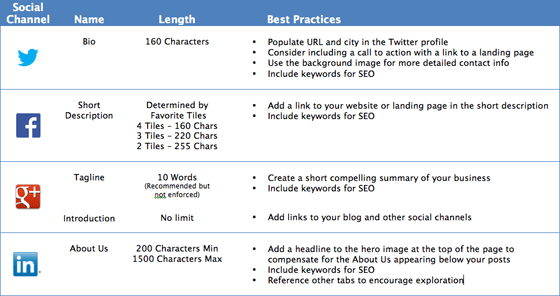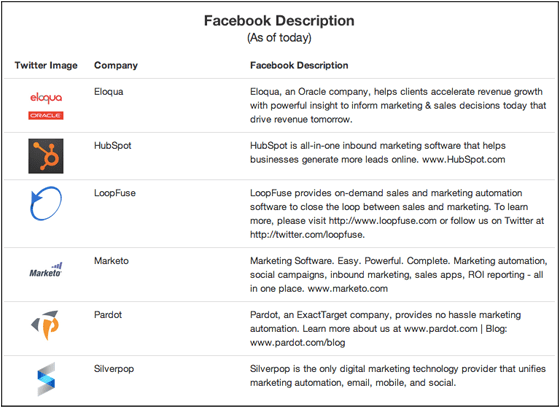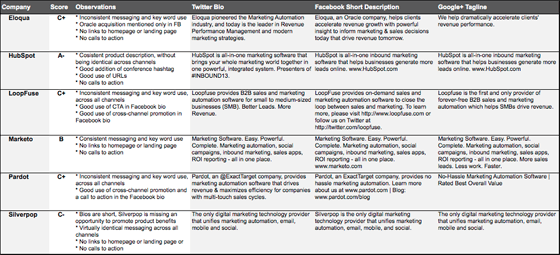
People spend hours rehearsing their elevator pitch. Getting it right means delivering a powerful value proposition in the time it takes to travel between floors – 30 seconds to two minutes. The goal is to connect and continue the conversation after the doors slide shut.
If you think about it, your social media bios are the elevator pitch of the digital age. You have ten to thirty seconds – and 160 characters – to convince someone to engage with you.

Are you investing time in your social media profiles? If you’re not, you should be.
To help maximize your “elevator time”, I’m going to share best practices, demonstrate the insight you can gain from your competitors’ descriptions and in a real world application of what we cover I’ll make a set of recommendations for how Silverpop can improve their Twitter, FaceBook and Google+ social bios.
In The Elevator With Marketo
Imagine you’ve come across a great tweet on marketing automation and visit the company’s twitter page to learn more – the equivalent of jumping on the elevator and hearing their pitch. You’re going to spend 20 seconds, then decide whether to follow them. In that scenario, who will you find more compelling Ad2action or Marketo?
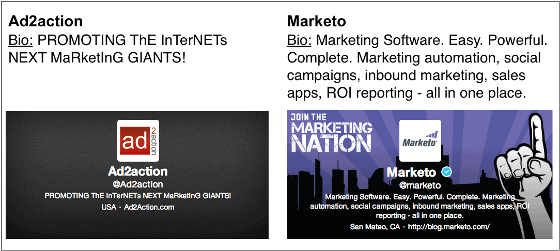
The majority of you will opt to follow Marketo. Their digital elevator pitch is visually interesting and they’ve used their 160 characters to tell you the benefits and breadth of what they do.
Perfecting Your Social Media Profile Bios
Imagine the sales rep pacing his office rehearsing his elevator pitch, prepping for the moment he finds himself face-to-face with the CEO of his key target. That’s you perfecting your social media bio. It takes work to get it right.
Quick Tips:
- Share your value proposition. Remember, you’re trying to convince prospects and influencers to engage with you – follow, circle, like and comment on your social media activity. Your bio should tell them what your company does and what benefits you deliver.
- Keep SEO in mind. Many of the search engines are using social media bios in their algorithms. Craft your bios to leverage key words while still offering prospects a compelling reason to engage.
- Use CTAs. Consider adding a call to action to your bio. Further engage your audience with the offer of a free trial, free taste, free download, etc.
- Include Links and Consider Landing Pages. Be sure to include a link in your bios and you should consider sending them to a landing page with targeted messaging instead of your homepage. Read more about this concept from ConversionXL.
- Be Visual. The visual richness of social media has increased dramatically—from the massive hero image on Google+ to the new twitter profile pages. Learn about the new visual specs in this post from LunaMetrics.
- Maximize Your Real Estate. It’s critical every word in your bio works hard. Common mistakes include informing visitors that they’ve reached “The Official channel of [company name]” and identifying the team of contributors.
Unfortunately for Chrysler, their Twitter bio is a great illustration of both the above errors.
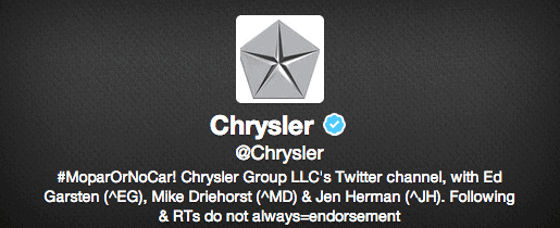
Quick Reference
Keeping track of best practices and specifications can be a challenge. All the channels have made changes in last 12 months. I’ve captured the basics in the reference tool below.
Stand Out From The Crowd.
Every three months you should review your social bios to ensure they’re in line with your current value proposition. At the same time, take a look at your competitors’ social media “elevator pitch” and determine if you need to counter their positioning.
You can use a spreadsheet, or a side-by-side comparison like the one below from, Rival IQ. Check out the Facebook short descriptions from companies in the marketing automation space.
Quickly you get a sense of each company’s value proposition. For example, Eloqua is claiming acceleration of revenue growth, Hubspot is promoting an “all in one” solution and more leads and Pardo is focused on “no hassle” marketing automation.
History Is Telling
If you track changes to your competitor’s social bios, you’ll be able to extract insights about how the market is evolving and inform your own marketing strategy. Here’s a look at how the marketing automation players changed their Twitter positioning over six months.
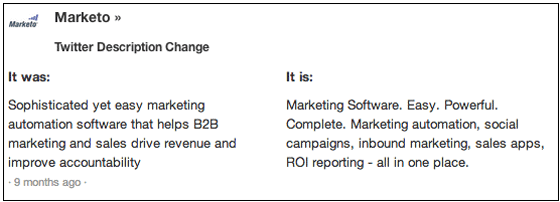
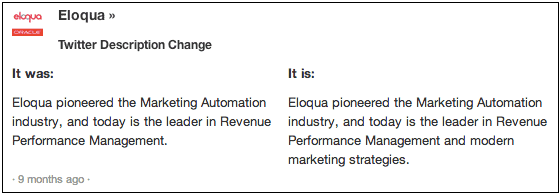
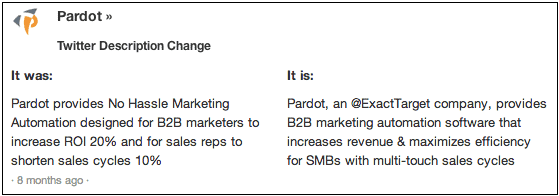
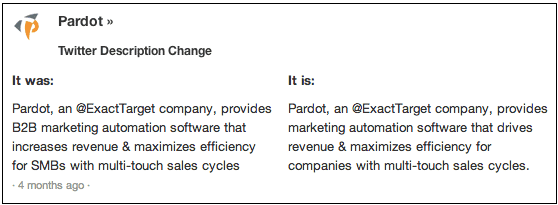
Based on this series of bio changes, I’d posit that Marketo kicked off a positioning shift that rippled through the market.
Consistency Counts.
The individuals you reach on social media don’t limit themselves to just one channel. They’re likely to engage with you on Twitter and Facebook, or Linked In and Twitter or maybe on three or four channels at once. When you’re optimizing one social media bio, it’s important to optimize all of them, reinforcing both key messages and key words.
Continuing to look at the marketing automation landscape, I’ve created a side-by-side comparison of Twitter, FaceBook and Google+ bios. Take a look and see who gets high marks.
While all the companies have room for improvement, I’m giving HubSpot the highest grade for consistency and use of best practices. Marketo goes too far by having identical bios across all channels and fails to use links or calls to action. Add to Marketo’s downfall the failure to maximize the length of their bios, and we find Silverpop at the bottom of the class.
Putting Learning Into Practice.
Let’s put our learning to work and suggest ways for Silverpop to improve their social media bios.
Below are the company’s current descriptions:
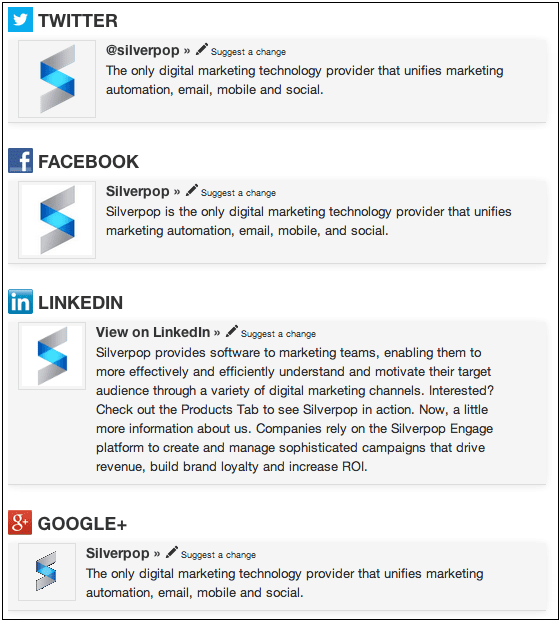
Best Practices Observations
- Share Your Value Proposition. Silverpop consistently describes what they do, but outside of the long-form Linked In description, fails to explain the benefits they deliver. This makes their bios less compelling to the reader.
- Maximize Your Real Estate. Silverpop can lengthen their bios to be more engaging. They have ~50 more characters available on Twitter alone.
- Include Links. Adding a link to SilverPop’s Facebook description is not only a best practice, it would bring them in line with what their competitors are doing. They’d receive bonus points for directing traffic to a landing page with more targeted messaging.
- Competitive Positioning. Reading through the competitive bios reveals that “unifying” channels may not differentiate Silverpop. HubSpot’s “all in one” positioning is virtually identical.
Recommendations
A quick survey of Silverpop’s website reveals elements of their value proposition that could better differentiate them in their social bios, including:
- “We know marketers because we are marketers.”
- They offer a “return on relationship” by leveraging unique customer behavior to deliver results
- They empower marketers to create and manage sophisticated campaigns that drive revenue, build brand loyalty and increase ROI.
- They are trusted by more than 5,000 brands worldwide.
Obviously the marketing team at Silverpop has a better understanding of their value proposition than I ever will – but to inspire them to evaluate their social media bios, I’ve drafted the following descriptions for consideration.
| Social Platform | What I’d Say |
| Marketing automation built by marketers. Leverage customer behavior across email, mobile and social to increase revenue & loyalty. Join us. www.silverpop.com (160 characters) | |
| Marketing automation built by marketers, trusted by over 5,000 brands. Leverage customer behavior across email, mobile and social to increase revenue, loyalty & ROI. Find your Return on Relationship. www.silverpop.com/FB (220 characters – perfect for three favorite tiles) | |
| Google+ | Leverage customer behavior across channels to increase revenue and loyalty. (10 words) |
Although these recommendations leverage best practices, they may not accurately communicate Silverpop’s unique value proposition. My point is that a quick review of your social bios, in comparison to the market, is all you need to inspire positioning changes that result in better differentiation and a great digital elevator pitch.
Key Takeaways
- As the elevator pitch of the digital age social bios are critical expressions of your value proposition and should be reviewed and optimized every 3 months
- Stay up to date on best practices and visual specifications so your bios are working hard for you
- Evaluate the your competitors bios (and those of companies you aspire to be like) for positioning insight and inspiration
- Track changes in positioning to identify subtle shifts that signal market movement
- Leverage marketing intelligence tools like Rival IQ to make tracking changes and comparing positioning easy (yes this is a shameless plug) or use your intern and a spreadsheet if they don’t mind tedious but incredibly valuable work :-).
